Fancy that: Expert tips for designing with fancy colour diamonds
by charlene_voisin | August 1, 2015 9:00 am
By Llyn L. Strelau
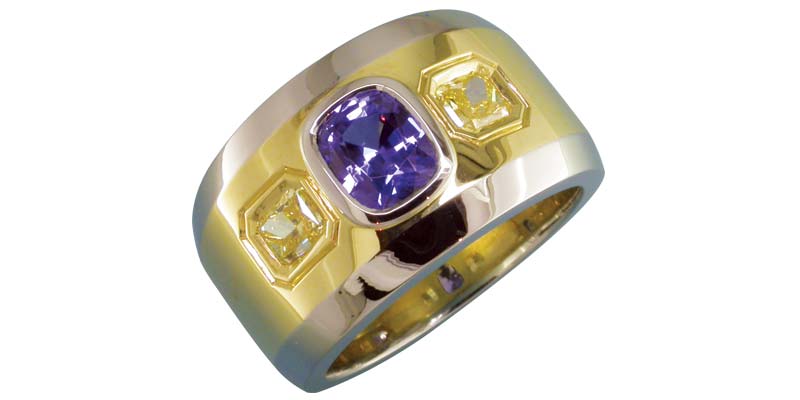 [1]
[1]
In the early days of my career, I turned up my nose at diamonds. The way I saw it, they were just boring white things that were way too expensive and had none of the interest I appreciated in coloured gemstones.
Naturally, I soon got over my snobbishness, as I discovered their many advantages, thanks to their durability and hardness, not to mention their beauty when cut well. Today, diamonds are a major part of my repertoire. When I discovered not all diamonds are white, it was the best of all possible worlds—the combination of the positive qualities of diamond with the beauty of colour!
Of course, natural fancy colour diamonds are extremely rare. Famous stones like the Dresden Green, the Hope Diamond, and the Hancock Red are the talk of legends. Despite this, coloured diamonds were, up until 30 years or so, the near-secret passion of savvy collectors, underappreciated by the general public or most of the industry, for that matter.
About the time I was getting started as a jeweller, the Argyle Mine in Australia came into full production. Although the rare and very desirable pink and red stones to come out of it were (and still are) beyond the reach of most people, cleverly Rio Tinto began promoting the much more plentiful brown-tone diamonds that were the bulk of the Argyle production, dubbing them ‘champagne’ diamonds. This infused glamour into brown diamonds—which were previously only a step above their industrial counterparts—and so began the love affair with coloured diamonds. For my part,”¨ I was immediately fascinated by the subtle and delicate lighter shades, and especially fond of the richer and more saturated cognac and chocolate stones, especially when they exhibited a hint of deep red.
In more recent years, consumers have become more aware of coloured diamonds and their desirability. Celebrity engagement rings and coloured diamonds in mainstream jewellery have increased interest not only for well-priced earth-tone stones, but also fancy yellows, and to a lesser extent, the vastly more expensive fancy pinks and even rarer blues, greens, and oranges. Black diamonds have also found their place in design, adding drama both for pavé accent and larger rose-cuts used as centre stones.
The shape of things
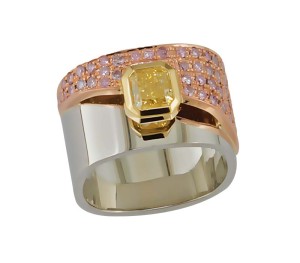 [2]
[2]Natural fancy colour diamonds can be found in most of the common shapes of their white counterparts. However, some faceting styles can maximize the colour of a fancy, which is especially useful when a stone’s saturation is lower. The radiant cut is very common, particularly for fancy light or fancy yellow stones, although you will see it in other colours, too. Cushion cuts have become very popular, as well as variations on the modified square shape. Round cuts are perhaps less common in larger sizes, while emerald cuts and baguettes are even less prevalent. For more rare colours like pink and blue, you may find stones that are either cut too shallow or deep because cutters are loath to waste any of the precious rough. When cut to excellent proportions, a natural fancy colour diamond is truly a rare thing of beauty. You may also see other fancy shape stones whose cut was likely chosen to maximize the recovery from the rough, again to avoid loss of valuable material. Black diamond melee is usually diamond cut for ease of use as pavé. For larger black stones, a brilliant cut is a waste of money, since you are paying by the carat for weight that adds nothing to appearance. Instead, high-dome rose cuts with many facets maximize their impact. Black diamonds do tend to have cavities and other surface imperfections, so look for the cleanest stones possible.
Complement or contrast?
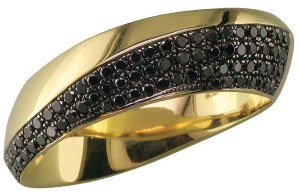 [3]
[3]Coloured diamonds offer many opportunities for the creative jeweller. Larger stones as the focal point of a design or pavé-set melee to provide visual support for the main stone offer effective use of coloured diamonds. Both contrasting and complementary combinations can increase these gems’ impact. This is especially true when the diamond colour is not highly saturated. Pink diamonds look even pinker when they are set with white, yellow, or blue diamonds. Blue diamonds, if you are fortunate enough to be able to work with them, are tricky. Unless they are fancy intense or vivid blue, they tend not to look very blue on their own. Accenting them with white, pink, or soft yellow diamonds can be effective, as the contrast highlights the blue stone. The rich greens of emerald and tsavorite or the blues and violets of sapphire and tanzanite pop when combined with yellow or pink diamonds. Rubies look ‘redder’ next to yellow diamonds (just as they do against a gem dealer’s acid yellow stone paper). Black diamonds, on the other hand, provide a classic dramatic contrast when combined with white diamonds.
Amping up the colour
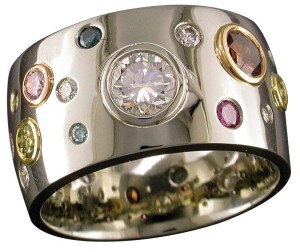 [4]
[4]The colour of metal used to set fancy diamonds is very important. Generally, it is best to match the colour of the gold to the stone’s colour. I typically use yellow gold (18 karat or even 24 karat) for yellow and brown diamonds and similarly rich rose gold for pink stones, green gold for green, and white gold or platinum for blue. (Electroplating metal with black rhodium can be effective in making the most of black diamonds.)
The ring to the right shows this technique with the larger diamonds bezel-set in gold that matches their colour. Smaller and more intensely coloured stones are flush-set in the white gold of the band.
Similarly, the pink, yellow, and rose gold bezels seen in the photo on the next page highlight the three fancy colour pear shapes in contrast with the high-colour white diamond set in platinum, all surrounded by matte white gold. This ring was a commission for a client for whom the three colours held significance to her faith. It also gave me my first opportunity to work with fancy coloured diamonds of significant size and value.
Each pear shape was approximately three quarters of a carat. The cost per carat of the natural fancy intense purplish-pink stone was more than four times that of the fancy intense yellow diamond. The natural fancy grey blue stone cost five times per carat more than the yellow stone. The ring was made more than 10 years ago and it’s pretty safe to say the stones have increased in value since then. This piece serves as a good example of the importance of certification for coloured diamonds. Without a report from a reputable lab certifying natural colour origin, the sale would probably not have happened.
The setting method can also impact the final appearance of a coloured diamond. You may see commercially produced jewellery where the fancy colour diamond is set in a closed-back setting (or nearly closed), such as a bezel or claw set. This ‘trick’ usually means the diamond is, in reality, much less intensely coloured than it appears in the mount.”¨A fancy light yellow diamond can face up as a fancy intense yellow if there is a sheet of high-carat yellow gold under the culet or just below the stone’s girdle. This is the equivalent to the practice of foil-backing gemstones seen in medieval and Renaissance jewellery (albeit most of the gems were rose cuts with flat backs) and can vastly improve the apparent quality of a stone. When a diamond’s actual colour grade is disclosed, the practice is perhaps valid, but I have seen several examples of clients who have purchased a ring (at auction, online, or while on a cruise) that either did not have a certificate or had one that was ‘less than accurate’ and misrepresented the stone as a better colour than it really was.
Just a brief reminder: Working with fancy colour diamonds requires some care. It is best to avoid soldering with the stone in place, especially in the case of treated stones, since the colour will likely be affected.
Natural or”¦
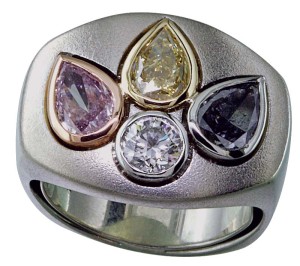 [5]
[5]Given the demand for fancy colour diamonds and the high prices they command, knowing the origin of their colour is critical. As for all gemstones, honest disclosure is mandatory; natural fancy colour diamonds (i.e. other than brown and light yellow) are very rare, and their value reflects that. If you are purchasing a significant stone, it is vital it carry a certificate of natural origin from a reputable laboratory to guarantee the source of the colour. As with the current situation involving undisclosed white lab-grown diamonds, there have been parcels of melee and even larger fancies ‘salted’ with either treated or man-made stones. It is a case of buyer beware.
Man has manipulated diamonds for centuries to change their colour. Early methods (fortunately not as often encountered today) included painting transparent colour on the girdle or, more effectively, on the stone’s culet. These ‘enhancements’ are fairly easy to discover, though if a stone is in a relatively closed-back setting, it can be more difficult. Any serious cleaning with an ultrasonic and steam removes the coatings.
Irradiation of natural diamonds to change their colour has been around for many years. Initially, this was mainly used to change off-colour brown or yellow stones to intense turquoise blue or deep yellow. However, in more recent years, a wider range of shades can be achieved using other methods. Varied combinations of high-pressure/high-temperature (HPHT) treatments have more recently allowed the production of diamonds in various intensities of yellow, pink, purple, green, and also more ‘natural’ shades of blue. Lab-created diamonds have become quite widely available in the last few years and some of the fancy colours are very attractive.
Designs to tickle your fancy
The plethora of treatments and the increased availability of lab-grown fancy colour diamonds have made it even more important for our industry to know what is out there. Some of the colours are obviously not ‘natural,’ while others can deceive even a trained gemmologist at first examination. If a stone presented as natural has a price that seems too good to be true, the warning flags should go up. A well-equipped gemmological laboratory should be able to determine origin.
If you or your client is only interested in the esthetics (and the durability advantages) of diamonds and wish to use HPHT-treated or lab-grown diamonds, they can be an excellent alternative at a fraction of the price of their naturally coloured cousins. There is certainly a market for these stones, but my personal feeling is they are not likely to increase in value over time (like natural diamonds) and are best marketed as attractive and durable gems.
A place for lab-growns in design
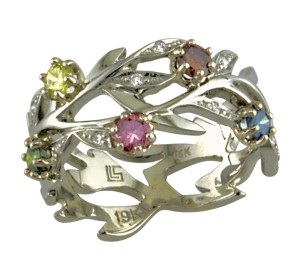 [11]
[11]Budget permitting, naturally coloured yellow and pink diamonds can be acquired with relative ease, while blue, green, and orange are so rare it would require extremely deep pockets to own one. This is probably the best use for lab-grown or HPHT-treated coloured diamonds, since there really is no practical alternative.
As seen in the photo to the right, this white gold ring with an open leaf design features five HPHT round diamonds. The rich colours combined with diamond brilliance resulted in a ring that can be worn daily without worrying about damaging the stones. Their relatively modest price made it possible; if one could even find natural fancy colour stones in these shades, the price would put the ring out of reach for anyone but the uber-wealthy.
If you are interested in delving further into the realm of fancy colour diamonds and their lab-grown counterparts, Gemological Institute of America (GIA) has an excellent trio of books published between 2005 and 2008: Colored Diamonds, Treated Diamonds, and Synthetic Diamonds. These volumes are compilations of articles from past issues of the institute’s journal, Gems and Gemology. GIA has updated and added to the information in more recent G&G issues, since there have been many advances in both the treatment of natural diamonds to improve or induce fancy colours, as well as new methods for synthesizing white and coloured diamonds.
 [12]Llyn L. Strelau is the owner of Jewels by Design, a designer-goldsmith studio in Calgary established in 1984. His firm specializes in custom jewellery design for a local and international clientele. Strelau has received numerous design awards, including the American Gem Trade Association’s (AGTA’s) Spectrum Awards and De Beers’ Beyond Tradition—A Celebration of Canadian Craft. His work has also been published in Masters: Gemstones, Major Works by Leading Jewelers. Strelau can be reached via e-mail at designer@jewelsbydesign.com[13].
[12]Llyn L. Strelau is the owner of Jewels by Design, a designer-goldsmith studio in Calgary established in 1984. His firm specializes in custom jewellery design for a local and international clientele. Strelau has received numerous design awards, including the American Gem Trade Association’s (AGTA’s) Spectrum Awards and De Beers’ Beyond Tradition—A Celebration of Canadian Craft. His work has also been published in Masters: Gemstones, Major Works by Leading Jewelers. Strelau can be reached via e-mail at designer@jewelsbydesign.com[13].
- [Image]: http://www.jewellerybusiness.com/wp-content/uploads/2015/11/sapphire-and-yellow-radiants.jpg
- [Image]: http://www.jewellerybusiness.com/wp-content/uploads/2015/11/pink-melee-with-yellow-radiant.jpg
- [Image]: http://www.jewellerybusiness.com/wp-content/uploads/2015/11/offset-yellow-band-black-pave.jpg
- [Image]: http://www.jewellerybusiness.com/wp-content/uploads/2015/11/multi-colour-bezel-and-flush-set-diamonds.jpg
- [Image]: http://www.jewellerybusiness.com/wp-content/uploads/2015/11/three-fancy-pear-shapes-with-round-diamond.jpg
- [Image]: http://www.jewellerybusiness.com/wp-content/uploads/2016/01/big-black-cushion-with-orange-and-white.jpg
- [Image]: http://www.jewellerybusiness.com/wp-content/uploads/2016/01/anticlastic-brown-and-yellwo-diamond-bangle.jpg
- [Image]: http://www.jewellerybusiness.com/wp-content/uploads/2016/01/kite-shape-yellow-diamond-bangle.jpg
- [Image]: http://www.jewellerybusiness.com/wp-content/uploads/2016/01/yellow-diamonds-pistachio-pearls.jpg
- [Image]: http://www.jewellerybusiness.com/wp-content/uploads/2016/01/gold-ribbon-bracelet-yellow-diamonds.jpg
- [Image]: http://www.jewellerybusiness.com/wp-content/uploads/2015/08/leaf-ring-treated-diamonds.jpg
- [Image]: http://www.jewellerybusiness.com/wp-content/uploads/2015/11/Llyn-Strelau-e1447864674717.jpg
- designer@jewelsbydesign.com: mailto:designer@jewelsbydesign.com
Source URL: https://www.jewellerybusiness.com/features/fancy-that-expert-tips-for-designing-with-fancy-colour-diamonds/
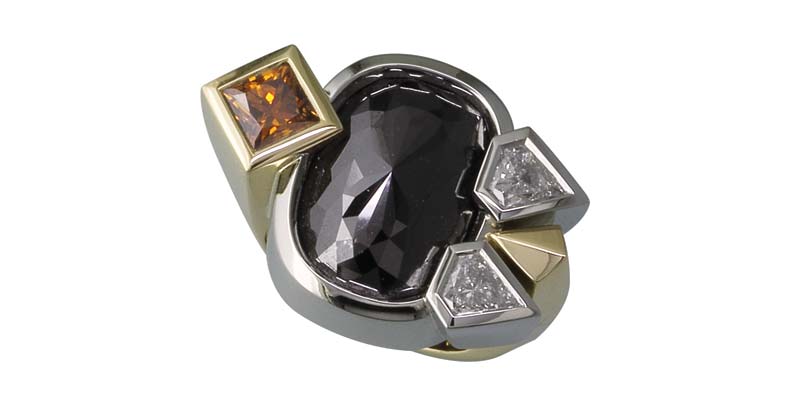 [6]
[6]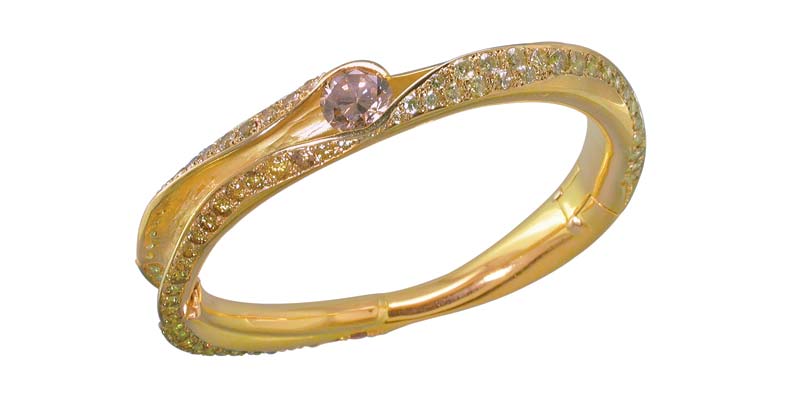 [7]
[7]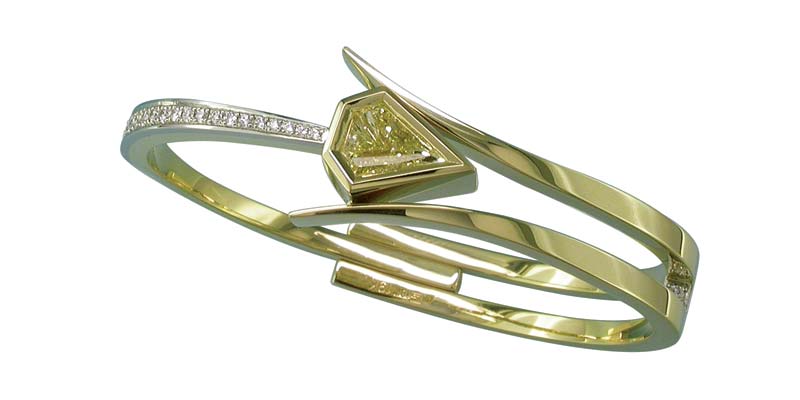 [8]
[8]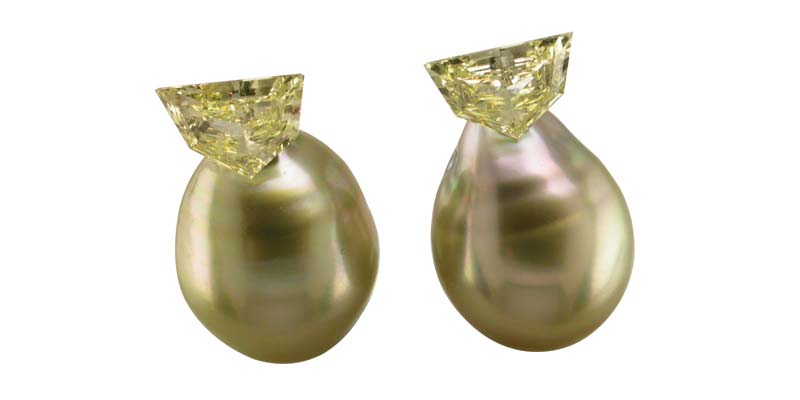 [9]
[9]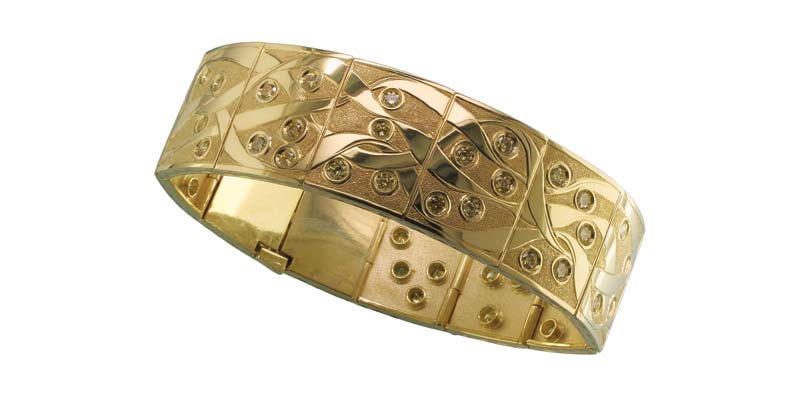 [10]
[10]



